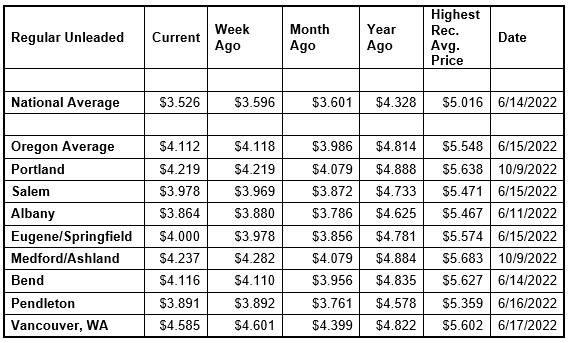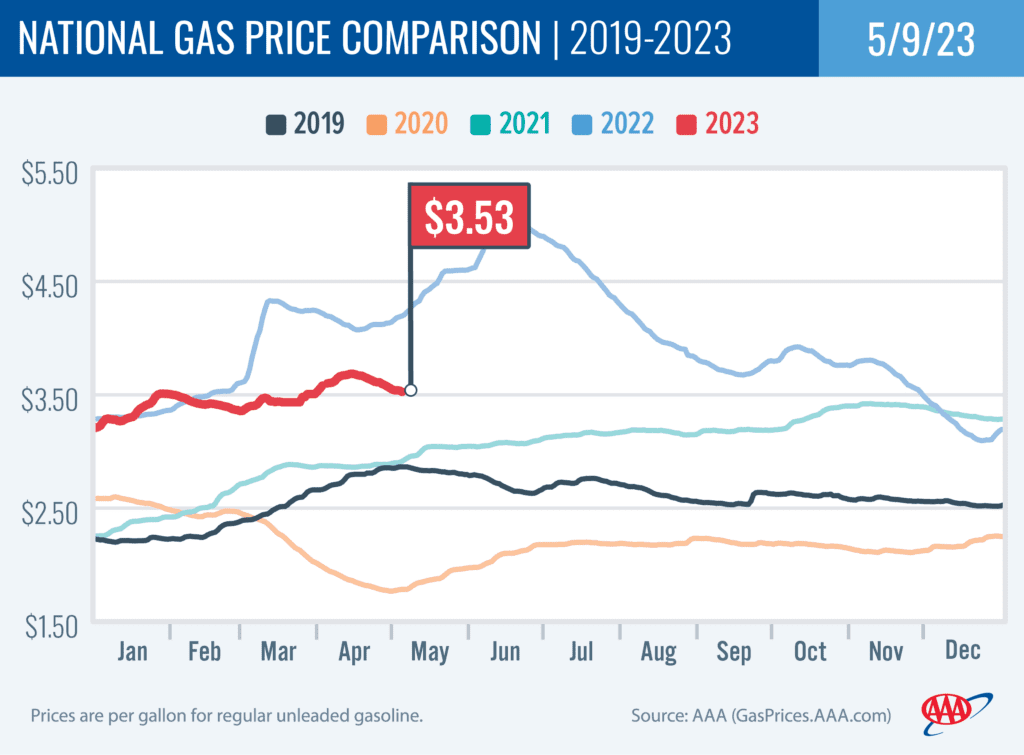PORTLAND, Ore., – Lower crude oil prices and a drop in U.S. demand for gas are helping to push pump prices lower in 47 states, including Oregon. Crude remains below $75 a barrel, and the transition to summer-blend fuel has mostly wrapped up across the country. For the week, the national average for regular drops seven cents to $3.53 a gallon. The Oregon average edges down about half a cent to $4.11.

“The national average appears to have peaked for the spring. It topped out at nearly $3.69 on April 20 and has steadily declined since then. The Oregon average reached its year-to-date high of $4.12 on May 3 and has slipped less than a penny since then. It’s too early to say if the Oregon average has peaked for the spring,” says Marie Dodds, public affairs director for AAA Oregon/Idaho. “Typically, gas prices will often reach their spring peak during the month of May.”
Crude oil prices slid last week, dropping below $70 per barrel on market concerns that rising interest rates will tip the U.S. economy into a recession. Crude prices fell below $80 per barrel on April 19. Oil prices rose above $80 per barrel after the April 2 announcement from the Organization of the Petroleum Exporting Countries and other major oil producers, including Russia, known collectively as OPEC+, that the cartel would cut oil production by just over 1 million b/d through the end of 2023.
“The volatility in crude oil prices and a lull in domestic demand for gas are leading to lower pump prices for now, barring unforeseen events that could impact supplies,” adds Dodds.
Crude oil is trading around $73 today compared to $72 a week ago and $103 a year ago. In April, West Texas Intermediate ranged between about $73 and $83. In March, WTI ranged between about $64 and $81 per barrel. In February, WTI ranged between about $73 and $80 per barrel. In January, WTI ranged between about $73 and $82 bbl. Crude reached recent highs of $123.70 on March 8, 2022, shortly after the Russian invasion of Ukraine, and $122.11 per barrel on June 8, 2022. The all-time high for WTI crude oil is $147.27 in July 2008.
Crude oil is the main ingredient in gasoline and diesel, so pump prices are impacted by crude prices on the global markets. On average, about 56% of what we pay for in a gallon of gasoline is for the price of crude oil, 20% is refining, 11% distribution and marketing, and 14% are taxes, according to the U.S. Energy Information Administration.
A factor that always puts upward pressure on pump prices in the spring is the seasonal switch to summer-blend fuel. California has an April 1 deadline to switch to summer-blend fuel, while the federally mandated deadline is May 1. The West Coast region often sees prices climb earlier than other parts of the country because of that earlier California deadline. This fuel is more environmentally friendly but more expensive to produce. More info on summer- and winter-blend gasoline can be found at the EPA website.
U.S. refineries often go off-line or have reduced output ahead of these seasonal switchovers so that maintenance can occur. Refinery operations have been restarted over the past few weeks, with some planned work extending into June.
Demand for gasoline in the U.S. demand dropped significantly from 9.51 to 8.62 million b/d for the week ending April 28. This compares to 8.86 million b/d a year ago. The drop in demand is more in line with what market observers expected last week. The estimate could be revised when EIA releases final demand measurements for May. Meanwhile, total domestic gasoline stocks increased by 1.8 million bbl to 222.9 million bbl. Lower demand, alongside an increase in stocks, has contributed to pushing pump prices lower. If demand remains low, drivers will likely continue to see pump prices decline.
Quick stats
Oregon is one of 47 states with lower prices now than a week ago. Ohio (-12 cents) has the largest weekly jump. Utah (+5 cents) has the largest weekly increase.
California ($4.82) has the most expensive gas in the nation for the 10th week in a row. Hawaii ($4.78) is second, Arizona ($4.69) is third, Washington ($4.59) is fourth, Nevada ($4.21) is fifth, and Oregon ($4.11) is sixth. These are the six states with averages at or above $4 a gallon. This week 43 states and the District of Columbia have averages in the $3-range. One state, Mississippi ($2.995) has an average in the $2 range this week, compared to no states a week ago.
The cheapest gas in the nation is in Mississippi ($2.995) and Texas ($3.06). For the 121st week in a row, no state has an average below $2 a gallon.
The difference between the most expensive and least expensive states is $1.82 this week, compared to $1.79 a week ago.
Oregon is one of 23 states with higher prices now than a month ago. The national average is eight cents less and the Oregon average is 13 cents more than a month ago. Ohio (-33 cents) has the largest monthly drop. Arizona (+30 cents) has the largest month-over-month increase.
Oregon is one of 49 states and the District of Columbia with lower prices now than a year ago. The national average is 80 cents less and the Oregon average is 70 cents less than a year ago. The District of Columbia (-$1.06) has the largest yearly drop. Washington (-25 cents) has the smallest. Arizona (+3 cents) is the only state with a year-over-year increase. A year ago, pump prices were rising rapidly after the start of the Russian invasion of Ukraine.
West Coast
The West Coast region continues to have the most expensive pump prices in the nation with all seven states in the top 10. It’s typical for the West Coast to have six or seven states in the top 10 as this region tends to consistently have fairly tight supplies, consuming about as much gasoline as is produced. In addition, this region is located relatively far from parts of the country where oil drilling, production and refining occurs, so transportation costs are higher. And environmental programs in this region add to the cost of production, storage and distribution.
| Rank | Region | Price on 5/9/23 | ||
| 1 | California | $4.82 | ||
| 2 | Hawaii | $4.78 | ||
| 3 | Arizona | $4.69 | ||
| 4 | Washington | $4.59 | ||
| 5 | Nevada | $4.21 | ||
| 6 | Oregon | $4.11 | ||
| 7 | Alaska | $3.98 | ||
| 8 | Illinois | $3.94 | ||
| 9 | Utah | $3.92 | ||
| 10 | Idaho | $3.75 |
As mentioned above, California has the most expensive gas in the nation for the 10th week in a row. Hawaii Arizona, Washington, Nevada, Oregon, and Alaska round out the top seven. Oregon is sixth for the third week in a row.
States in the West Coast region are seeing small changes on the week. California (-4 cents), Nevada (-4 cents), Arizona (-2 cents), Washington (-1 cent) and Oregon (-6/10ths of a cent) have week-over-week declines. Alaska (+4/10ths of a cent) is the only state in the region with a weekly increase.
The refinery utilization rate on the West Coast fell from 86.6% to 80.7% for the week ending April 28. This rate has ranged between about 73% to 92% in the last year. The latest national refinery utilization rate is 90.7%.
According to EIA’s latest weekly report, total gas stocks in the region decreased from 31.46 million bbl. to 30.77 million bbl.
A lower refinery utilization rate and a decrease in gasoline stocks can put upward pressure on pump prices.
Oil market dynamics
Crude oil prices rebounded back into the $70s per barrel to start this week after a positive U.S. jobs report for April, which helped to ease recession fears. Another factor pushing crude prices higher are the wildfires in Canada which caused oil producers in Alberta to shut down production. Oil prices decreased to the upper $60s per barrel last week amid ongoing market concerns that rising interest rates will tip the economy into a recession. If a recession occurs, oil demand and prices will likely decline. Additionally, the EIA reported that total domestic commercial crude inventories decreased by 1.3 million bbl to 459.6 million bbl last week.
At the close of Friday’s formal trading session, WTI jumped $2.78 to settle at $71.34. At the close of Monday’s formal trading session, WTI added $1.82 cents to close at $73.16. Today crude is trading around $72, compared to $72 a week ago. Crude prices are about $37 less than a year ago.
Drivers can find current gas prices along their route with the free AAA Mobile app for iPhone, iPad and Android. The app can also be used to map a route, find discounts, book a hotel and access AAA roadside assistance. Learn more at AAA.com/mobile.

Diesel
For the week, the national average falls seven cents to $4.05 a gallon. The record high is $5.816 set on June 19, 2022. The Oregon average falls a nickel to $4.50. The record high is $6.47 set on July 3, 2022. A year ago the national average for diesel was $5.54 and the Oregon average was $5.60.
Find current fuel prices at GasPrices.AAA.com.
AAA news releases, high resolution images, broadcast-quality video, fact sheets and podcasts are available on the AAA NewsRoom at NewsRoom.AAA.com.
Find local news releases at https://oregon.aaa.com/community/media/media-contacts.html
Fuel prices are updated daily at AAA’s Daily Fuel Gauge at AAA Gas Prices. For more info go www.AAA.com. AAA Oregon/Idaho provides more than 875,000 members with travel, insurance, financial and automotive-related services, and is an affiliate of AAA National, serving more than 63 million motorists in North America.

